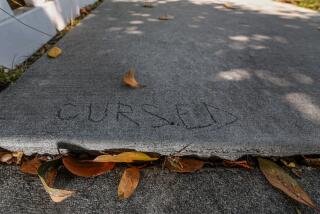Editorial: California should be making it easier to walk in cities. That means no more bogus jaywalking tickets
Believe it or not, you can get a $250 jaywalking ticket for crossing the street even if you were in the crosswalk and the traffic light was green — if you started after the crosswalk clock began ticking down.
In recent years the Los Angeles Police Department has conducted stings downtown, handing out tickets to unlucky pedestrians who get caught doing what many thought was perfectly legal — that is, starting across during the countdown. Turns out, it’s not legal. California law says you’re not allowed to set foot in the street once the “Don’t Walk” or red hand signal begins flashing, even if there is still plenty of time on the countdown.
In other words, the point of the countdown isn’t to help you decide whether you have enough time to cross, even though that would make sense. It’s to tell the pedestrians already in the crosswalk how much time they have to get to the other side.
Now, two lawmakers from L.A. and San Francisco have introduced a bill — sponsored by the city of Los Angeles — to change that law, allowing pedestrians to proceed “if there is sufficient time left on the countdown to reasonably complete the crossing safely.” This is a common-sense fix that should end pedestrian confusion and put a stop to bogus jaywalking tickets.
California law says you’re not allowed to set foot in the street once the ‘Don’t Walk’ signal begins flashing, even if there is still plenty of time.
Assembly Bill 390 by Assembly members Miguel Santiago (D-Los Angeles) and Phil Ting (D-San Francisco) is a much-needed modernization of the current state law, which was written before the advent of countdown crosswalks.
The intersection timers were first tried in San Francisco in 2001 as a way to let walkers know how much time they had to cross the street. The pilot program was hugely successful, reducing pedestrian injury collisions by more than 50%, according to a study published by the Institute of Transportation Engineers. There was also a noticeable reduction in the number of pedestrians still in the crosswalk when the signal turned red. Additional studies have also found that countdown timers reduce the number of pedestrians hit by cars. But — not surprisingly — researchers have also found that pedestrians are more likely to step into the street after a countdown timer starts than after an old-school red hand signals begins flashing.
This makes sense. Countdown timers give pedestrians useful information so they can decide whether to cross the street or wait. “Fifteen seconds? I can make it if I walk fast.” “Five seconds? I’ll wait until the next cycle.”
Within a few years of San Francisco’s pilot project, state regulators decided to require countdown timers at all crosswalks where the walk sign — the so-called pedestrian change interval — lasts longer than seven seconds. But while countdown crosswalks have become ubiquitous in California cities, most walkers are clueless that state law still forbids crossing after the countdown starts until they get a very expensive jaywalking ticket.
The proposed tweak to state law would still leave room for police officers to ticket people who behave recklessly or actually impede the flow of traffic. Pedestrians who enter late in the countdown and fail to make it across the street in time would — and should — still be candidates for a jaywalking ticket.
AB 390 should be viewed as part of broader campaign to encourage and protect pedestrians. Through its Vision Zero initiative to eliminate traffic fatalities, Los Angeles and other cities are experimenting with engineering changes designed to make walking safer. Those include building curb extensions at intersections to reduce the walking distance, and giving pedestrians the “walk” signal a few seconds before cars get the green light. This head start means walkers are more visible to drivers making a turn.
For better health, fewer greenhouse gases and less traffic, California laws should encourage, not penalize, pedestrians. It’s time to modernize state law to match the state’s goals.
Follow the Opinion section on Twitter @latimesopinion and Facebook
More to Read
A cure for the common opinion
Get thought-provoking perspectives with our weekly newsletter.
You may occasionally receive promotional content from the Los Angeles Times.










